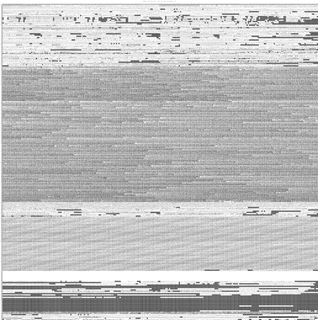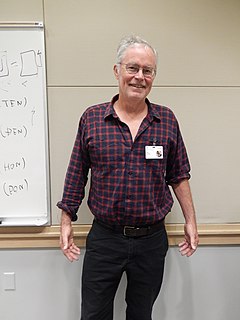Related Research Articles

Character encoding is the process of assigning numbers to graphical characters, especially the written characters of human language, allowing them to be stored, transmitted, and transformed using digital computers. The numerical values that make up a character encoding are known as "code points" and collectively comprise a "code space", a "code page", or a "character map".

In computing, plain text is a loose term for data that represent only characters of readable material but not its graphical representation nor other objects. It may also include a limited number of "whitespace" characters that affect simple arrangement of text, such as spaces, line breaks, or tabulation characters. Plain text is different from formatted text, where style information is included; from structured text, where structural parts of the document such as paragraphs, sections, and the like are identified; and from binary files in which some portions must be interpreted as binary objects.

Unicode, formally The Unicode Standard is an information technology standard for the consistent encoding, representation, and handling of text expressed in most of the world's writing systems. The standard, which is maintained by the Unicode Consortium, defines as of the current version (14.0) 144,697 characters covering 159 modern and historic scripts, as well as symbols, emoji, and non-visual control and formatting codes.
UTF-8 is a variable-width character encoding used for electronic communication. Defined by the Unicode Standard, the name is derived from UnicodeTransformation Format – 8-bit.

UTF-16 (16-bit Unicode Transformation Format) is a character encoding capable of encoding all 1,112,064 valid character code points of Unicode (in fact this number of code points is dictated by the design of UTF-16). The encoding is variable-length, as code points are encoded with one or two 16-bit code units. UTF-16 arose from an earlier obsolete fixed-width 16-bit encoding, now known as UCS-2 (for 2-byte Universal Character Set), once it became clear that more than 216 (65,536) code points were needed.
The symbol # is known variously in English-speaking regions as the number sign, hash, or pound sign. The symbol has historically been used for a wide range of purposes including the designation of an ordinal number and as a ligatured abbreviation for pounds avoirdupois – having been derived from the now-rare ℔.
Han unification is an effort by the authors of Unicode and the Universal Character Set to map multiple character sets of the Han characters of the so-called CJK languages into a single set of unified characters. Han characters are a feature shared in common by written Chinese (hanzi), Japanese (kanji), Korean (hanja) and Vietnamese.

The Unicode Consortium is a 501(c)(3) non-profit organization incorporated and based in Mountain View, California. Its primary purpose is to maintain and publish the Unicode Standard which was developed with the intention of replacing existing character encoding schemes which are limited in size and scope, and are incompatible with multilingual environments. The consortium describes its overall purpose as:
...enabl[ing] people around the world to use computers in any language, by providing freely-available specifications and data to form the foundation for software internationalization in all major operating systems, search engines, applications, and the World Wide Web. An essential part of this purpose is to standardize, maintain, educate and engage academic and scientific communities, and the general public about, make publicly available, promote, and disseminate to the public a standard character encoding that provides for an allocation for more than a million characters.
In character encoding terminology, a code point, codepoint or code position is a numerical value that maps to a specific character. Code points usually represent a single grapheme—usually a letter, digit, punctuation mark, or whitespace—but sometimes represent symbols, control characters, or formatting. The set of all possible code points within a given encoding/character set make up that encoding's codespace.
In computer programming, whitespace is any character or series of characters that represent horizontal or vertical space in typography. When rendered, a whitespace character does not correspond to a visible mark, but typically does occupy an area on a page. For example, the common whitespace symbol U+0020 SPACE represents a blank space punctuation character in text, used as a word divider in Western scripts.
A Unicode font is a computer font that maps glyphs to code points defined in the Unicode Standard. The vast majority of modern computer fonts use Unicode mappings, even those fonts which only include glyphs for a single writing system, or even only support the basic Latin alphabet. Fonts which support a wide range of Unicode scripts and Unicode symbols are sometimes referred to as "pan-Unicode fonts", although as the maximum number of glyphs that can be defined in a TrueType font is restricted to 65,535, it is not possible for a single font to provide individual glyphs for all defined Unicode characters. This article lists some widely used Unicode fonts that support a comparatively large number and broad range of Unicode characters.
Letterlike Symbols is a Unicode block containing 80 characters which are constructed mainly from the glyphs of one or more letters. In addition to this block, Unicode includes full styled mathematical alphabets, although Unicode does not explicitly categorise these characters as being "letterlike".

The Unicode Consortium and the ISO/IEC JTC 1/SC 2/WG 2 jointly collaborate on the list of the characters in the Universal Coded Character Set. The Universal Coded Character Set, most commonly called the Universal Character Set, is an international standard to map characters, discrete symbols used in natural language, mathematics, music, and other domains, to unique machine-readable data values. By creating this mapping, the UCS enables computer software vendors to interoperate, and transmit—interchange—UCS-encoded text strings from one to another. Because it is a universal map, it can be used to represent multiple languages at the same time. This avoids the confusion of using multiple legacy character encodings, which can result in the same sequence of codes having multiple interpretations depending on the character encoding in use, resulting in mojibake if the wrong one is chosen.
The Universal Coded Character Set is a standard set of characters defined by the international standard ISO/IEC 10646, Information technology — Universal Coded Character Set (UCS), which is the basis of many character encodings, improving as characters from previously unrepresented typing systems are added.
Tamil All Character Encoding (TACE16) is a 16-bit Unicode-based character encoding scheme for Tamil language.

Lee Collins is a software engineer and co-founder of the Unicode Consortium. In 1987, along with Joe Becker and Mark Davis they began to develop what is today known as Unicode. Collins has a Master of Arts in East Asian Languages and Cultures from Columbia University and was the Technical Vice President of Unicode Consortium from 1991 to 1993.
Robert L. Belleville is an American computer engineer who was an early head of engineering at Apple from 1982 until 1985.
The Xerox Character Code Standard (XCCS) is a historical 16-bit character encoding that was created by Xerox in 1980 for the exchange of information between elements of the Xerox Network Systems Architecture. It encodes the characters required for languages using the Latin, Arabic, Hebrew, Greek and Cyrillic scripts, the Chinese, Japanese and Korean writing systems, and technical symbols.
The ISO 2033:1983 standard defines character sets for use with Optical Character Recognition or Magnetic Ink Character Recognition systems. The Japanese standard JIS X 9010:1984 is closely related.
David G. Opstad is a retired American computer scientist specializing during his career in computer typography and information processing, leading to several breakthroughs. Opstad was a contributor to Unicode 1.0, together with Joe Becker, Lee Collins, Huan-mei Liao, and Nelson Ng.
References
- ↑ d. Becker, Joseph (1984). "Multilingual Word Processing". Scientific American. 251 (1): 96–107. Bibcode:1984SciAm.251a..96B. doi:10.1038/scientificamerican0784-96. JSTOR 24969416.
- ↑ Gary F. Simons (1998). "The Nature of Linguistic Data and the Requirements of a Computing Environment for Linguistic Research". In Helen Aristar Dry; John Lawler (eds.). Using Computers in Linguistics: A Practical Guide . ISBN 978-0415167932.
- ↑ Scott Gardner (25 January 2009). The Definitive Guide to Pylons. Apress. p. 218. ISBN 978-1-4302-0534-0.
The origins of Unicode date back to 1987 when Joe Becker, Lee Collins, and Mark Davis started investigating the practicalities of creating a universal character set.
- ↑ "Summary". History of Unicode.
- ↑ "Early Years of Unicode". History of Unicode.
- ↑ Becker, Joseph D. (1998-09-10) [1988-08-29]. "Unicode 88" (PDF). unicode.org (10th anniversary reprint ed.). Unicode Consortium. Archived (PDF) from the original on 2016-11-25. Retrieved 2016-10-25.
In 1978, the initial proposal for a set of "Universal Signs" was made by Bob Belleville at Xerox PARC. Many persons contributed ideas to the development of a new encoding design. Beginning in 1980, these efforts evolved into the Xerox Character Code Standard (XCCS) by the present author, a multilingual encoding which has been maintained by Xerox as an internal corporate standard since 1982, through the efforts of Ed Smura, Ron Pellar, and others.
Unicode arose as the result of eight years of working experience with XCCS. Its fundamental differences from XCCS were proposed by Peter Fenwick and Dave Opstad (pure 16-bit codes), and by Lee Collins (ideographic character unification). Unicode retains the many features of XCCS whose utility have been proved over the years in an international line of communication multilingual system products.